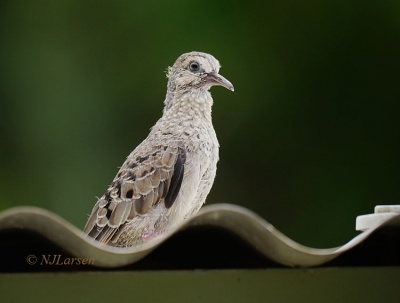- Zenaida aurita
Identification
28-30cm
Brown to reddish-brown over most of the plumage, with Lesser Antillean birds showing a paler abdomen. At the lower edge of the auriculars is a black mark similar to what is seen in many similar doves, and below it is an area of the neck with a metallic purple or pink sheen. A pale blue eye-ring shown in some field guides is inconspicuous. The folded wing shows some black spots, and the white tips to the secondaries are sometimes visible. Primary tips are blackish. Legs are short and pink while the bill is black.
Flight
In flight, when seen from above, the short tail with white tips combined with the white tips to the secondaries are destinctive. In addition, notice that all flight feathers are dark, while the rest of the body looks reddish-brown. The wings often give off a whistling sound in flight. From the underside, the Lesser Antillean subspecies has white underwing coverts, which combined with the white abdomen results in a rather white impression if the upperside is not seen.
Distribution
Zenaida Dove is found from coastal Northern Yucatán with islands through Greater Antilles and Lesser Antilles with Grenada the Southernmost spot.
Taxonomy
Subspecies
The species is divided into three subspecies basically corresponding to each of these areas[1]:
- Z. a. salvadorii:
- Coastal northern Yucatán Peninsula, Cozumel, Holbox and Isla Mujeres
- Z. a. zenaida:
- Z. a. aurita:
- Lesser Antilles (Anguilla to Grenada)
Habitat
Open and semi-open habitats. At least in Puerto Rico, it seem that the recently arrived White-winged Dove co-exists with Zenaida Dove without significant competition[2].
Behaviour
Breeding
It builds a flimsy platform on a tree or shrub, or in rock crevices and on grassy vegetation if no predators are present. 2 white eggs are laid and incubtated for approximately two weeks; the young fledge after a further two weeks. Parents feed the young pigeon's milk, a nutrient rich substance regurgitated from its crop.
Diet
The diet includes seeds, grains and insects. They often swallow fine gravel to assist with digestion, and will also ingest salt from mineral rich soils or livestock salt licks.
Vocalisation
One description is Coo-i oh oh oh where the second part of first syllable rises sharply, while all the rest is at the same tone. Sounds very mournful, has been compared to Mourning Dove.
Threat display
Occasionally, one will see a bird lift one wing and slam it down making a loud noise. This is usually done as part of interactions between two birds, one of which want the other to keep its distance.
References
- Clements, J. F., T. S. Schulenberg, M. J. Iliff, D. Roberson, T. A. Fredericks, B. L. Sullivan, and C. L. Wood. 2014. The eBird/Clements checklist of birds of the world: Version 6.9., with updates to August 2014. Downloaded from http://www.birds.cornell.edu/clementschecklist/download/
- RIVERA-MILAN, F.F. 1996. Nest density and success of columbids in Puerto Rico. The Condor 98:100-113.
- Birdforum member personal experience
Recommended Citation
- BirdForum Opus contributors. (2025) Zenaida Dove. In: BirdForum, the forum for wild birds and birding. Retrieved 25 April 2025 from https://www.birdforum.net/opus/Zenaida_Dove
External Links
GSearch checked for 2020 platform.1






